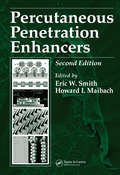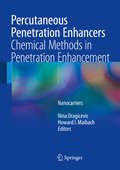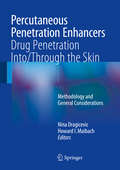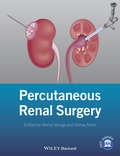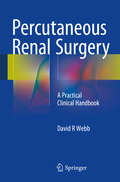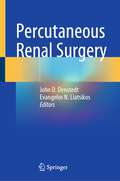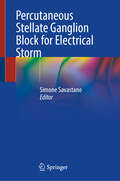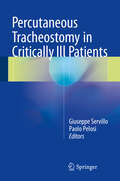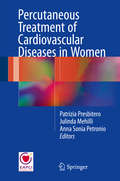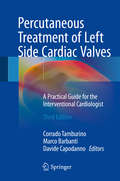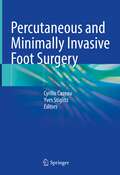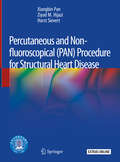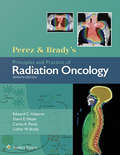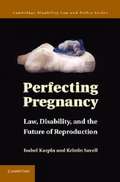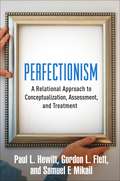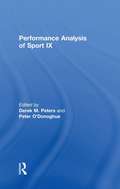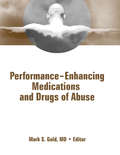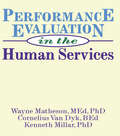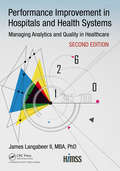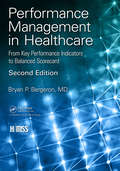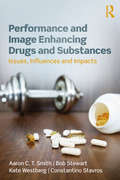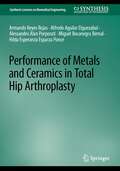- Table View
- List View
Percutaneous Penetration Enhancers
by Paul C. H. LiThoroughly updated, this second edition is the most comprehensive reference on the methods available for the enhancement of percutaneous penetration. The book examines a broad scope of chemical enhancers and various physical methods of enhancement. The range of chemicals discussed is, arguably, unsurpassed anywhere in the literature. This edition contains comprehensive descriptions of the latest techniques and several chapters cover the modern analytical techniques adapted to assess and measure penetration enhancement. New to this volume are chapters addressing penetration retardation, important for substances such as sunscreen agents, for which skin penetration is not desirable.
Percutaneous Penetration Enhancers Chemical Methods in Penetration Enhancement
by Howard I. Maibach Nina DragicevicPercutaneous Penetration Enhancers in a mini-series format comprising five volumes, represents the most comprehensive reference on enhancement methods - both well established and recently introduced - in the field of dermal/transdermal drug delivery. In detail the broad range of both chemical and physical methods used to enhance the skin delivery of drugs is described. All aspects of drug delivery and measurement of penetration are covered and the latest findings are provided on skin structure and function, mathematics in skin permeation and modern analytical techniques adapted to assess and measure penetration. In offering a detailed description of the methods currently in use for penetration enhancement, this book will be of value for researchers, pharmaceutical scientists, practitioners and also students.
Percutaneous Penetration Enhancers Drug Penetration Into/Through the Skin
by Howard I. Maibach Nina DragicevicPercutaneous Penetration Enhancers in a mini-series format comprising five volumes, represents the most comprehensive reference on enhancement methods - both well established and recently introduced - in the field of dermal/transdermal drug delivery. In detail the broad range of both chemical and physical methods used to enhance the skin delivery of drugs is described. All aspects of drug delivery and measurement of penetration are covered, and the latest findings are provided on skin structure and function, mathematics in skin permeation, and modern analytical techniques adapted to assess and measure penetration. In offering a detailed description of the methods currently in use for penetration enhancement, this book will be of value for researchers, pharmaceutical scientists, practitioners, students and dermatological scientists or dermatologists.
Percutaneous Renal Surgery
by Manoj Monga Abhay RanePercutaneous Renal Surgery will provide surgeons and urologists/nephrologists with a well-illustrated, full-colour expert guide to performing these complex and difficult surgical procedures safely and effectively.Focus throughout is on percutaneous management of three major conditions: large renal calculi (percutaneous nephrolithotomy), transitional cell cancer (percutaneous resection of tumor) and renal cell cancer (percutaneous cryotherapy and radiofrequency ablation).For each of these conditions, leading surgeons and urologists will cover:Epidemiology of the diseaseEvolution of evidence-based outcomes for percutaneous managementPatient selection and informed consentInstrumentationSurgical technique10 high-quality videos of surgery in action will provide an excellent visual guide to best practice and tips/tricks while performing surgery, making this a perfect multi-media teaching tool.
Percutaneous Renal Surgery
by David R WebbThis is the first textbook devoted entirely to percutaneous renal surgery. The text explains the basic anatomy, instruments, track dilation and creation, kidney access and surgical treatment of all complex stone scenarios. The book is written in simple sections and is extensively illustrated with more than 250 illustrations. All diagrams have been drawn by the author and reproduced by a professional graphic artist. The book describes the basic techniques, then progresses clinically through to more difficult clinical and surgical scenarios. In this way, it is akin to a "cook book" in style, that is easily referenced and readable. As percutaneous renal surgery is a team effort, the book contains descriptors for ward and theatre technicians and nurses, as well as equipment lists. The book also contains a "do it yourself" six-stage percutaneous renal surgery workshop program. This workshop can be performed in any department practising PCNL. Percutaneous Renal Surgery: A Practical Clinical Handbook represents a practical manual, suitable for medical students, nurses and technicians and is a unique manual for all urology trainees and urologists treating renal stone disease worldwide.
Percutaneous Renal Surgery
by John D. Denstedt Evangelos N. LiatsikosIn the ever-evolving field of urology, percutaneous renal surgery (PCNL) for kidney stones stands at the forefront of innovation and excellence and offers an alternative to traditional open surgery. This book, Percutaneous Renal Surgery, delves into the intricacies of percutaneous renal surgery, providing a thorough exploration of the latest techniques, advancements, and best practices. Featuring contributions from international experts in the field, each chapter covers the key aspects of percutaneous renal surgery, including patient selection, preoperative evaluation, procedural nuances, postoperative care, and potential complications. From navigating renal anatomy to mastering the latest instruments and technologies, you'll gain the knowledge and confidence needed to excel in this specialized discipline. Discover the benefits of percutaneous renal surgery, such as reduced invasiveness, shorter hospital stays, enhanced patient outcomes, and improved quality of life. Explore its applications in treating kidney stones, urothelial cancer, and other urological conditions. Delve into the art of accessing the kidney through percutaneous techniques, utilizing fluoroscopy, ultrasound, and other imaging modalities.With its comprehensive coverage and insightful guidance, Percutaneous Renal Surgery empowers urologists to push the boundaries of patient care and redefine what is possible in the field of urology.
Percutaneous Stellate Ganglion Block for Electrical Storm
by Simone SavastanoElectrical storm presents a challenging cardiological emergency with limited treatment options. Pharmacological interventions are often ineffective, while non-pharmacological treatments requiring specialized skills or equipment may not be readily available. Physicians face the daunting task of stabilizing critically ill patients with recurrent ventricular arrhythmias, often with high mortality rates. Transporting patients to specialized centres for advanced treatments like transcatheter ablation or circulatory support may be necessary. Percutaneous stellate ganglion block emerges as a crucial intervention in this context. Originally developed for pain management, its antiarrhythmic potential became evident in the 1970s with the understanding of the autonomic nervous system's role in arrhythmogenesis. This manual aims to provide insights into the rationale, efficacy, safety, and execution technique of stellate ganglion block, offering a valuable addition to the therapeutic armamentarium for arrhythmic storm. It covers various aspects from ventricular arrhythmia pathophysiology to modern treatment approaches and the influence of the autonomic nervous system. The text reviews literature supporting the technique's antiarrhythmic efficacy and provides detailed guidance on its execution using anatomical landmarks and imaging.
Percutaneous Tracheostomy in Critically Ill Patients
by Giuseppe Servillo Paolo PelosiThis book provides an up-to-date and comprehensive overview on percutaneous tracheostomy (PT) in critically ill patients. The various PT techniques that may be employed in the intensive care unit are fully described, with discussion of the available tracheostomy tubes and selection criteria and with clear evaluation of the risks and benefits of each procedure. A further individual chapter is devoted to the methods of airway management that may be used during PT. Detailed attention is also paid to medical and nursing management inside and outside hospital, to quality of life issues in tracheostomized patients, and to the problem of informed consent. The book concludes by addressing the need for standard guidelines. Percutaneous Tracheostomy in Critically Ill Patients will be an excellent source of information and guidance for novice and more experienced physicians working in intensive care units, operating rooms, and emergency departments as well as for those responsible for patient aftercare.
Percutaneous Treatment of Cardiovascular Diseases in Women
by Patrizia Presbitero Julinda Mehilli Anna Sonia PetronioThis book describes a wide range of interventional procedures currently employed in the treatment of cardiac diseases in women with the aim of enabling not only interventional cardiologists but also cardiologists and cardiac surgeons to refine their approach to female patients and thus improve outcomes. The book reflects the increasing awareness of gender differences with regard to coronary artery disease and structural valve heart disease. Examples include myocardial infarction, which carries a worse prognosis in women in part because they suffer from this disease mostly in the 7th decade of life, present more frequently with hemodynamic instability and later from symptom onset, and have fragile, small and tortuous coronary arteries that are more technically demanding in the context of primary percutaneous coronary intervention. Another example is symptomatic aortic stenosis, which carries a better prognosis in women who undergo trans-catheter aortic valve implantation partially due to a better annulus-prosthesis match, which leads to less residual paravalvular regurgitation, better left ventricular function and lower aggregation of comorbidities. Further, in women left ventricular response to aortic stenosis is typified by muscle hypertrophy with a small ventricular cavity. These differences are reflected in the clinical manifestations and their impact on diagnosis, treatment, and choice of tools and devices for use in interventional procedures. By explaining the at times subtle variances in disease and treatment techniques for female and male patients, this book will help practitioners select the most appropriate procedures and materials in a range of settings.
Percutaneous Treatment of Left Side Cardiac Valves: A Practical Guide For The Interventional Cardiologists
by Corrado Tamburino Marco Barbanti Davide CapodannoAfter the success of the first two editions, this expanded and extensively revised edition provides the interventional cardiologist with detailed, state of the art information on key techniques and approaches to percutaneous treatment of left side cardiac valve disease, keeping pace with the rapid and dynamic evolution in the discipline. Many new techniques and resources are now available, including new devices for transcatheter aortic valve implantation and new approaches to transcatheter mitral valve replacement. Numerous images will help the reader to understand the steps of each procedure and the characteristics of the different devices available. The potential complications and expected or potential morbidity from each procedure are discussed in depth, along with the best ways to manage them. Transcatheter aortic valve implantation has revolutionized the field of interventional cardiology. Initially envisaged as a palliative technique for inoperable patients, it now offers high-risk patients a viable alternative to surgery. Several techniques are also available of transcatheter mitral valve repair, and initial cases of transcatheter mitral valve replacement have also been reported: the interest in these techniques is such that further significant technological advances are expected to be seen over the next few years. This highly informative, easy to read, and carefully structured guide provides interventional cardiologists with updated knowledge on the application of transcatheter techniques to cardiac valves.
Percutaneous and Minimally Invasive Foot Surgery
by Cyrille Cazeau Yves StiglitzThis book on percutaneous and minimally invasive foot surgery comprehensively covers one of the most innovative topics in orthopedic surgery, discussing decision-making based on foot biomechanics and presenting step-by-step descriptions of each surgical procedure. The chapters are divided into four sections, the first of which lays the groundwork for further reading by providing a comprehensive overview of the biomechanical approach. The second part then guides readers through making appropriate choices in order to ensure stable corrections and allow immediate full weight-bearing and fast rehabilitation without compromising patient outcomes. In the third part, leading surgeons in the field describe each procedure step-by-step with the help of operative pictures, while the last part addresses technical postoperative issues, such as postoperative dressing and cast management, as well as complications and how to reduce them. All chapters are richly illustrated and clearly highlight the key points for successful surgery and minimized risks. Unique in its focus on percutaneous and minimally invasive foot surgery, this book offers an invaluable resource for postgraduate students, residents, orthopedists wanting to specialize in foot surgery, as well as practicing orthopedic surgeons and podiatrists.
Percutaneous and Non-fluoroscopical (PAN) Procedure for Structural Heart Disease
by Horst Sievert Ziyad M. Hijazi Xiangbin PanThis book provides an extensive discussion of echocardiography-guided percutaneous interventional techniques for clinical practitioners, including cardiologists, interventional physicians, surgeons and specialist training candidates. It allows readers to gain a thorough understanding of interpreting echocardiography-guided procedures, which not only protect patients from pain and other complications associated with conventional surgery, but also obviate the use of fluoroscopy or contrast agents and so avoid radiation damage and the risks of allergy or renal function impairment. Further, these procedures could help to save patients in areas lacking medical resources. The book first demonstrates the substitution of transesophageal for transthoracic echocardiography to avoid intubation under general anesthesia, and then presents key technical and practical aspects of echo-guided percutaneous interventions for structural heart diseases, such as ASD, VSD, PDA, PS, MS, AS and CoA. Lastly, it explores the lessons learned in echocardiography, anesthesia and postprocedural management of echo-guided percutaneous interventions.
Perez & Brady's Principles and Practice of Radiation Oncology
by David E. Wazer Luther W. Brady Carlos A. Perez Edward C. HalperinPublisher's Note: Products purchased from 3rd Party sellers are not guaranteed by the Publisher for quality, authenticity, or access to any online entitlements included with the product. For more than 30 years, Perez and Brady's Principles and Practice of Radiation Oncology has been the must-have standard reference for radiation oncologists and radiation oncology residents who need a comprehensive text covering both the biological and physical science aspects of this complex field as well as disease site-specific information on the integrated, multidisciplinary management of patients with cancer. The book has established itself as the discipline’s "text-of-record," belonging on the shelf of all of those working in the field. The Seventh Edition continues this tradition of excellence with extensive updates throughout, many new chapters, and more than 1,400 full-color illustrations that highlight key concepts in tumor pathogenesis, diagnosis, and targeted radiation therapy.
Perfecting Pregnancy
by Isabel Karpin Kristin SavellPrenatal and preimplantation testing technologies have offered unprecedented access to information about the genetic and congenital makeup of our prospective progeny. Future developments such as preconception testing, noninvasive prenatal testing, and more extensive preimplantation testing promise to increase that access further still. The result may be greater reproductive choice, but it also increases the burden on women and men to avail themselves of these technologies in order to avoid having a child who has a disability. The overwhelming question for legislators has been whether and, if so, how to regulate the use of these technologies in the face of compelling but seemingly contradictory claims about the advancement of reproductive choice and the dangers of eugenic or discriminatory effects. This book examines the evolution of this legislative oversight across a number of jurisdictions and explores the tensions and ambiguities that inform these laws.
Perfection Salad: Women and Cooking at the Turn of the Century
by Laura ShapiroPerfection Salad presents an entertaining and erudite social history of women and cooking at the turn of the twentieth century. With sly humor and lucid insight, Laura Shapiro uncovers our ancestors widespread obsession with food, and in doing so, tells us why we think as we do about food today. This edition includes a new Introduction by Michael Stern, who, with Jane Stern, is the author of Gourmet magazine's popular column Roadfood and the book Eat Your Way Across the U. S. A.
Perfectionism: A Relational Approach to Conceptualization, Assessment, and Treatment
by Gordon L. Flett Paul L. Hewitt Samuel F. MikailGrounded in decades of influential research, this book thoroughly examines perfectionism: how it develops, its underlying mechanisms and psychological costs, and how to target it effectively in psychotherapy. The authors describe how perfectionistic tendencies--rooted in early relational and developmental experiences--make people vulnerable to a wide range of clinical problems. They present an integrative treatment approach and demonstrate ways to tailor interventions to the needs of individual clients. A group treatment model is also detailed. State-of-the-art assessment tools are discussed (and provided at the companion website). Throughout the book, vivid clinical illustrations make the core ideas and techniques concrete.
Perfektionismus überwinden
by Nils SpitzerDieses Buch zeigt, wie Optimierungszwang, Perfektionismus und Exzellenzstreben uns antreiben und belasten können – und es bietet ein Selbsthilfeprogramm, um einen belastenden Perfektionismus zu verändern, sowie Gegenbilder, wie wir uns aus der Leistungsfalle befreien können. Die Gesellschaft feiert Perfektionismus und Selbstoptimierung. Die Kehrseite: Die Reihe der psychischen Probleme, mit denen Perfektionismus in Zusammenhang gebracht wird, verlängert sich immer mehr: Erschöpfung und Aufschiebeverhalten, heftige Schamgefühle und Stress, Depression, Ess- und Zwangsstörung oder soziale Ängste ebenso wie Selbstmordgedanken, Grübeln und Burnout. Dieser Ratgeber zeigt Lösungswege, sich aus diesem Widerspruch des Perfektionismus – gewünschte Erfolgsorientierung und psychisch belastende Folgen – zu befreien. Geschrieben für Betroffene und Interessierte. Psychologische Psychotherapeuten, Psychiater, Psychotherapeuten und Berater können das Buch therapie- und beratungsbegleitend empfehlen.
Performance Analysis of Sport IX
by Peter O'Donoghue Derek PetersPerformance analysis techniques help coaches, athletes and sport science support officers to develop a better understanding of sport performance and therefore to devise more effective methods for improving that performance. Performance Analysis of Sport IX is the latest in a series of volumes that showcase the very latest scientific research into performance analysis, helping to bridge the gap between theory and practice in sport. Drawing on data from a wide variety of sports, the book covers every key topic and sub-discipline in performance analysis, including: analysis of technique technical effectiveness tactical evaluation studying patterns of play motor learning and feedback work rate and physical demands performance analysis technology analysis of elite athletes and teams effectiveness of performance analysis support observational analysis of injury risk analysis of referees Effective performance analysis is now an essential component of the high performance strategy of any elite sport team or individual athlete. This book is therefore essential reading for any advanced student or researcher working in performance analysis, and invaluable reading for any sport science support officer, coach or athletic trainer looking for ways to improve their work with athletes
Performance Enhancing Medications and Drugs of Abuse
by Mark GoldPerformance Enhancing Medications and Drugs of Abuse explores various medications currently being abused by patients, from the drugs used for physical and cosmetic purposes by weekend warriors, professional athletes, and other at-risk populations, to the drugs used to enhance mood and memory.
Performance Evaluation in the Human Services
by Simon Slavin Wayne Matheson Kenneth Millar Cornelius Van DykPerformance Evaluation in the Human Services is a practical, specific book for managers on how to conduct performance evaluations. The book moves beyond the traditional rating scale and focuses on a new model involving the employee in the evaluation process. It stresses the need for evaluation scales to match the job description in a manner that is educational, future-oriented, and time-saving. Managers who must conduct performance reviews will find that this book presents a unique advancement on the use of behaviorally anchored rating scales for evaluation. The authors focus on the developmental/educational components of evaluation and stress employee empowerment as a result of evaluation.The authors have created an employee review system with three core components. The new appraisal model works on a “One Size Fits All” philosophy. It can be applied to all employees while the exact evaluating qualities differ as each job description does. Fundamental features of this new evaluative model include: the use of the “Benchmark” concept, a scale which indicates the level of the organization’s expectations and balances the administrative (evaluative) components and professional (developmental) issues BARS, Behaviorally Anchored Rating Scales CORE and A LA CARTE Dimensions which allows for evaluation of generic aspects of performance and job specific components the use of traditional approaches to evaluation such as trait-based scales and forced comparison techniquesThe rating system in Performance Evaluation in the Human Services serves as a means of identifying areas for middle and upper managers to identify areas for employees’professional growth and self-development. This approach is goal-oriented and can change and grow with the employee and the organization. Most importantly, it is built by both staff and management to be used as a tool for working together to define specific job requirements and how these requirements can be met and evaluated.
Performance Improvement in Hospitals and Health Systems: Managing Analytics and Quality in Healthcare, 2nd Edition (HIMSS Book Series)
by James R. Langabeer IIHealthcare Organizations offer significant opportunities for change and improvement in their overall performance. Hospitals and clinics are generally large, complex, and inefficient, and need serious development in process workflow and management systems, which will ultimately lead to better patient and financial outcomes. The National Academy of Medicine has stated that hospital systems are broken, and that they must begin by "… improving hospital efficiency and patient flow, and using operational management methods and information technologies." In fact, costs and quality are two of the important aspects of the "triple aim" in healthcare. One area that offers significant potential for improvement is through the application of performance improvement methods to patient and process flows. Performance improvement has a significant impact on a hospital’s over financial and strategic performance. Performance improvement involves the deployment of quantitative and scientific methods to model and influence the functioning of organizations. Performance improvement professionals are tasked with managing a variety of activities, such as deploying new information technologies, serving as project managers for construction events, re-engineering departmental process workflow, eliminating bottlenecks, and improving the flow and movement of patients between resource-intensive clinical areas. All of these are high risk, and require use of advanced, sophisticated methods to improve efficiency and quality, while minimizing disruptions from change. This updated edition is a comprehensive and concise guide to performance improvement in healthcare. It describes the management engineering principles focused on designing optimal management and information systems and processes. Case studies and examples are integrated throughout all chapters.
Performance Management in Healthcare: From Key Performance Indicators to Balanced Scorecard (HIMSS Book Series)
by Bryan P. BergeronPerformance management, often referred to as process management, is a strategy that can be used to achieve an optimum mix of quality, safety, patient satisfaction and solvency. The basis of performance management is the effective use of resources, as measured by quantifying processes and outcomes using key performance indicators (KPIs) – core measures that gauge the performance of an organization in particular areas. There is more to performance management than selecting a few KPIs from a list and feeding them into a graphical dashboard system. It’s about behavior change, leadership, and vision. Written for administrators, clinical staff, process improvement managers and information technology personnel of healthcare organizations, this second edition provides the knowledge necessary to provide the leadership and vision for a performance measurement initiative. This practical resource provides a high-level review of the quality/safety initiatives in healthcare, describes the implementation process from an IT perspective, and offers high-level clinical, financial and cultural details. It features an extensive listing of clinical and non-clinical KPIs: a glossary including financial, medical, and operational terms; and appendices of organizations and sources of indicators and benchmarks.
Performance Measurement for Health System Improvement
by Peter C. Smith Elias Mossialos Irene Papanicolas Sheila LeathermanIn a world where there is increasing demand for the performance of health providers to be measured, there is a need for a more strategic vision of the role that performance measurement can play in securing health system improvement. This volume meets this need by presenting the opportunities and challenges associated with performance measurement in a framework that is clear and easy to understand. It examines the various levels at which health system performance is undertaken, the technical instruments and tools available, and the implications using these may have for those charged with the governance of the health system. Technical material is presented in an accessible way and is illustrated with examples from all over the world. Performance Measurement for Health System Improvement is an authoritative and practical guide for policy makers, regulators, patient groups and researchers.
Performance and Image Enhancing Drugs and Substances: Issues, Influences and Impacts
by Bob Stewart Aaron Smith Constantino Stavros Kate WestbergIn the pursuit of more muscle, enhanced strength, sustained endurance and idealised physiques, an increasing number of elite athletes, recreational sport enthusiasts and body-conscious gym-users are turning to performance and image enhancing drugs and substances (PIEDS). In many instances, such use occurs with little regard for the health, social and economic consequences. This book presents a nuanced, evidence-based examination of PIEDS. It provides a classification of PIEDS types, physical impacts, rates of use, user profiles, legal and sporting status, and remedial program interventions, covering both elite and recreational use. It offers the perfect guide to assist students, government policy makers and sport managers in understanding the complex issues surrounding PIEDS consumption.
Performance of Metals and Ceramics in Total Hip Arthroplasty (Synthesis Lectures on Biomedical Engineering)
by Armando Reyes Rojas Alfredo Aguilar Elguezabal Alessandro Alan Porporati Miguel Bocanegra Bernal Hilda Esperanza Esparza PonceThis book offers expert guidance on materials for total hip arthroplasty (THA), providing readers with quick access to well-organized summaries on biomaterials such as metals, ceramics, polymers, and composites. It also includes in-depth coverage of biocompatibility and implant problems such as necrosis, ulceration, high toxicity with metals, and allergic reactions. Coverage also emphasizes the mechanical properties of the materials used for prostheses applications, immunity to corrosion, enhanced biocompatibility, complete inertness to the body environment, and the high capacity to join with the bone and other tissues. Performance of Metals and Ceramics in Total Hip Arthroplasty is an essential reference for engineers and scientists specializing in prostheses design and manufacturing and orthopedic medical professionals. The book can also be used as a study guide for materials science and orthopedics students.
